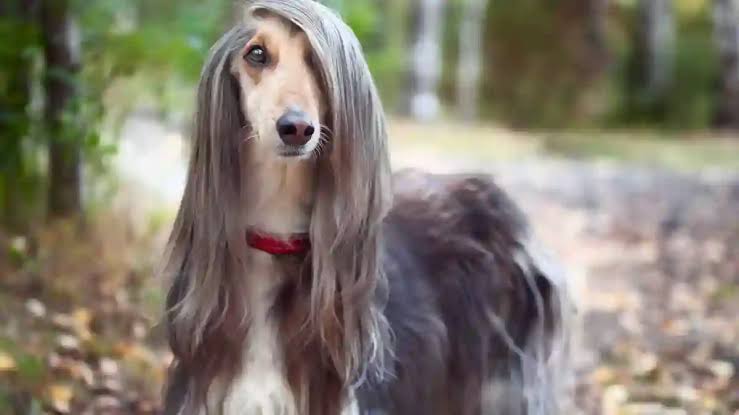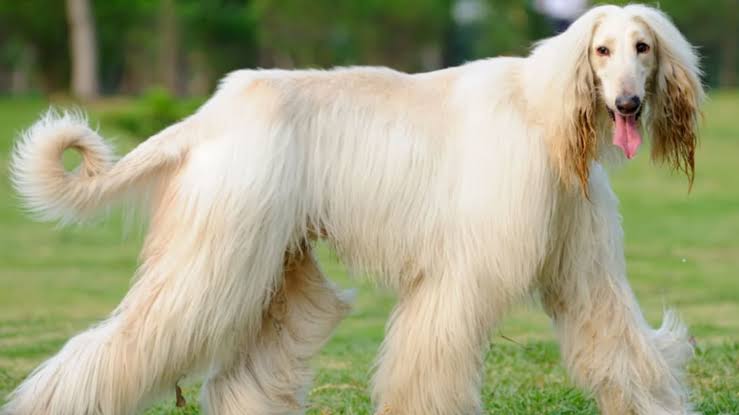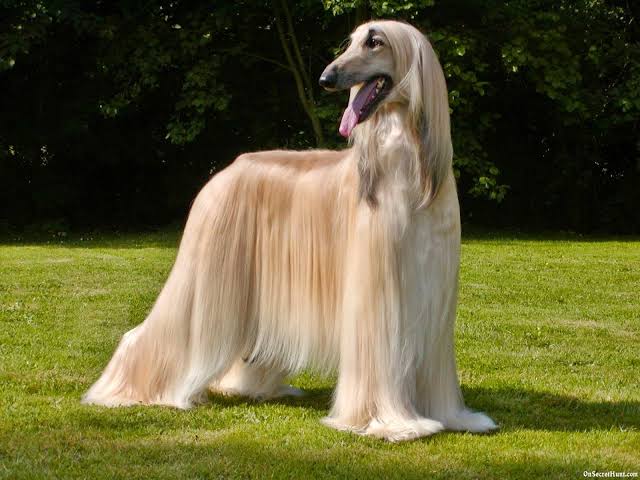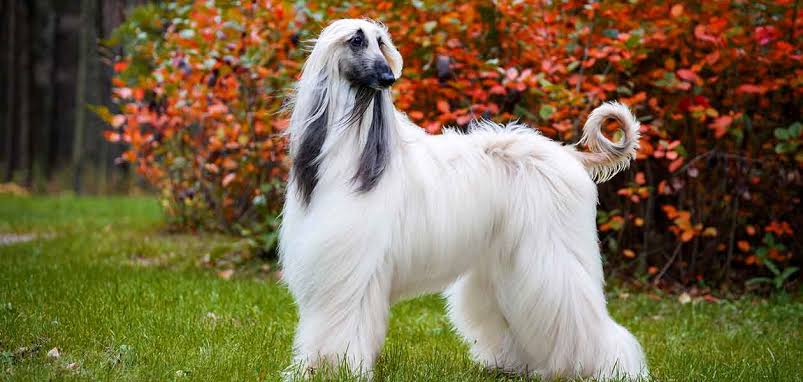The Afghan Hound is a breed of hound with a distinctive thick coat and ring curl tail. It has been selectively bred in the cold mountains of Afghanistan. Its local names include T Spay and Sag-e Tz. Read on to learn more about this breed. Listed below are some of the important facts about the Afghan Hound.

Breed standard
The Afghan Hound has a full set of white teeth and a level or scissors bite. It has long, broad hocks. The feet are shaped to provide agility on rocky terrain. The forefeet are large and the pads are thick. The rear feet are as long as the front ones, but not as broad. They point forward and are covered with long, fine-textured hair.
The Afghan Hound’s head is long and proud, with prominent ears and a long tail with a ring or curve at the end. The tail is carried high and is held proudly. The breed standard requires that Afghan Hounds be long, square, and strong, with the head and body proportionate to their length and shape.
The Afghan Hound is a tall, elegant breed, standing between 25 and 27 inches at the shoulder and weighing between 50 and 60 pounds. Its coat is short and silky, and it is often black or brindle in color. The Afghan hound has a prominent nose and long ears. Their eyes are dark and almond-shaped. The tail is long and curls upward, making it unique and distinctive.
Because of the Afghan Hound’s high level of energy, it is important to ensure adequate exercise for your dog in order to prevent destructive behavior. Besides daily exercise, Afghans enjoy soft beds and cuddly furniture. They also like to gallop in fenced areas. If given enough exercise, Afghans may even adapt to apartment living.

Appearance
The Afghan Hound is one of the oldest breeds of dog. According to legend, Noah brought two Afghans on board the ark. These dogs are famous for their thick and fine coats, as well as their powerful hunting abilities. These dogs also have big, thick feet. After the 1919 Afghan War, Major Amps based his base in the area surrounding Kabul.
The Afghan Hound’s physical appearance is quite different from other breeds. They have an aristocratic appearance, with their head held high, and their eyes staring into the distance. The Afghan Hound has a long, silky topknot and a distinctive coat pattern. Their feet are large and pointed in front. The Afghan Hound also has an exaggerated bend in the stifle, which is caused by their trousering.
The Afghan Hound is a large, tall dog. They typically measure twenty-five to twenty-seven inches at the shoulder. They weigh between fifty and sixty pounds. Their eyes are deep brown or black and are set at a high angle. Their ears are also long and covered with longer hair. The Afghan Hound’s coat is long, fine, and glossy, and it is usually black, tan, or red.
The Afghan Hound has a thick coat that covers most of their body. However, they eat less than their size suggests, so a high-quality dog food is essential to their overall health. You can also consider getting ear stockings for your Afghan, which will prevent their long ears from soiling when they eat.

Grooming
Grooming an Afghan Hound is one of the most important steps you can take to maintain your dog’s health and appearance. The thick coat and ring curl tail of the breed give it its distinctive look. These hounds were selectively bred in the mountains of Afghanistan. They are also known by their local names T Spay and Sag-e Tz.
Grooming your Afghan Hound is a very simple task, but it does require a certain level of knowledge. It is important to use grooming products that are safe for your dog, as harsh ingredients may irritate it. The grooming process should be performed slowly and carefully, so as not to irritate your pet.
To begin, first hand-stripping is essential. Once the coat has been cleaned, use a finishing spray or oil to add shine to it. The best oils for cottony coats are Alpha Keri oil and Neutrogena body oil. Never use baby oil or any other oil with your dog’s coat.
Afghan Hounds need daily grooming and bathing. They should also be clipped every couple of months. Grooming should be done by a professional at least once a year.

Health
If you have an Afghan Hound at home, you need to ensure that he’s healthy. Several diseases and conditions can affect this breed. While most dog owners don’t have to worry about cancer, Afghans are particularly susceptible to a condition called chylothorax, which causes the chest cavity to fill with a milky substance. This condition can be life threatening and requires immediate medical attention. Symptoms of chylothorax include lethargy and difficulty breathing.
Many Afghan Hound health problems are preventable by early detection and treatment. The breed is relatively healthy and can live up to 14 years old, but it can still contract conditions. Some of these conditions are not apparent until the dog is older, so you should take your dog to the vet as soon as possible. Regular visits to the veterinarian will detect visible issues and help you develop preventative regimens.
Another factor that can negatively affect the health of an Afghan Hound is improper nutrition. It takes 24 months for an Afghan Hound to reach adulthood, so proper nutrition is essential for the dog’s health. Moreover, Afghan Hounds should be fed a large-breed-specific diet to help them develop their bodies properly.
The Afghan Hound is a member of the sighthound family, which has evolved to be highly efficient in hunting. Its unique features include a thick, silky coat, prominent hips, and a small, doughnut-shaped tail. Its long, narrow muzzle and ears are covered with longer hair. Its long ears are easily soiled when it eats, and it’s important to keep their ears clean.

Cost
The Afghan Hound is an intelligent, independent dog that requires a large yard to run and play in. Though this breed is gentle and loving with children, it also needs to be trained to enter and exit doors and gates. In addition, this breed needs plenty of exercise so that it can stay healthy. These dogs also need to be trained to keep them safe indoors and away from other dogs, cats, and small children.
Afghan Hounds have a long, luxurious coat that requires daily brushing and professional grooming. This can cost up to $65 per visit, and can be an expensive investment for new owners. Grooming Afghan Hounds can be costly and requires special knowledge, especially if you are inexperienced with dogs.
Choosing a breeder who specializes in Afghan Hound puppies is a great way to reduce the cost of owning an Afghan Hound. It is important to consider that a well-known breeder will have higher prices than less reputable breeders. Additionally, a reputable breeder will have a reputation for raising good quality dogs.
The Afghan Hound is an ancient breed that has existed for centuries. In the past, nomads in Afghanistan used them to hunt large game. The Afghan Hound was so powerful that it could grab the neck of a large animal. The dog was also used to help shepherds and hunters.

Care requirements
The Afghan Hound is a versatile breed, which requires a high level of care. They must be well-fed and get plenty of exercise to stay healthy. The breed is capable of adapting to urban living, although it will do best in homes with ample yard space. This breed can also tolerate small children and other pets.
Afghan Hounds should be bathed at least twice a month. The frequency of bathing will depend on your area and the climate your dog lives in. Dogs living in humid climates need to bathe more often than those living in drier climates. Regular bathing is required to prevent excessive shedding of the coat, and it should be followed by thorough brushing to prevent tangles.
Afghan Hounds need to be fed high-quality dog food. This is usually available at supermarkets and convenience stores. However, it is best to consult with your veterinarian for a dietary plan that suits your dog’s needs. It is also important to keep in mind that Afghan Hounds should never be given human food, as it contains harmful substances.
The Afghan Hound is vulnerable to a number of diseases. Some of these are related to the dog’s digestive system, such as gastric dilatation and volvulus. A dog with this condition is at increased risk of developing bloat. If the stomach is too full, it will begin to swell, cutting off the blood supply to the spleen and stomach. This condition can be fatal within 30 minutes. You will know your dog has bloat if it behaves restlessly, has a large abdomen, and adopts a prayer-like posture. You can treat this condition with dietary supplements.
